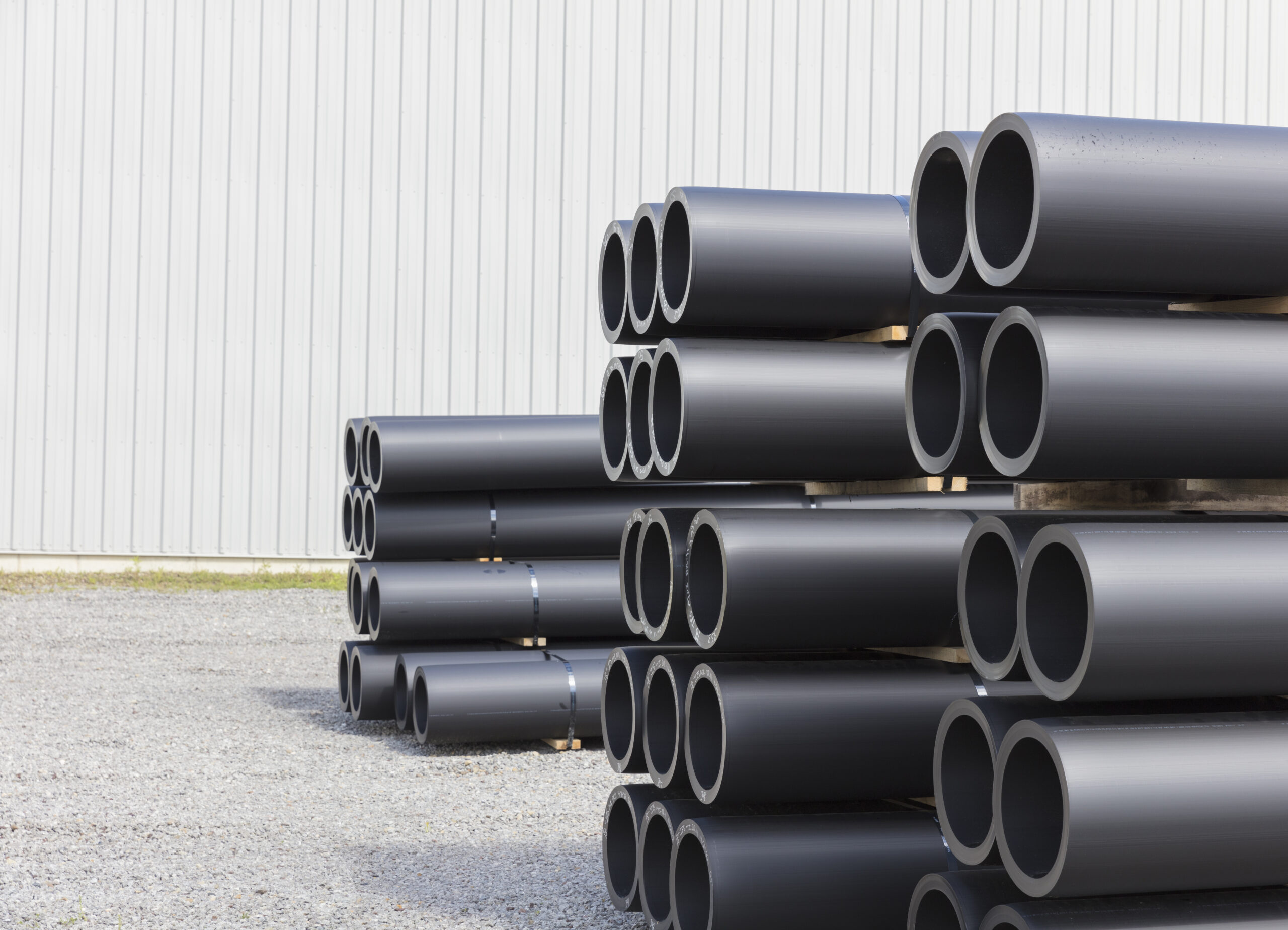How hdpe pipe suppliers Midland TX Are Transforming Oil and Gas
Wiki Article
Explore the Manufacturing Process Behind High-Quality HDPE Pipeline and Its Applications
The manufacturing process of premium HDPE pipes is complex and methodical. It begins with the option of resources that boost efficiency. Following this, ethylene goes through polymerization to create resin, which is after that formed through extrusion. Quality control is extremely important, making certain that the end product meets strict requirements. However, the journey of HDPE pipelines does not end with manufacturing. Their applications throughout numerous sectors reveal a wider relevance worth taking a look at.Comprehending HDPE: Properties and Advantages

High-density polyethylene (HDPE) is a functional polycarbonate known for its longevity and resistance to various environmental factors. This material displays superb tensile stamina, making it ideal for requiring applications. Its low-density structure adds to a lightweight item, facilitating convenience of dealing with and setup. HDPE likewise showcases impressive resistance to chemicals, which minimizes deterioration when subjected to rough substances.
The material's reduced wetness absorption better boosts its longevity, making it ideal for usage in pipelines and tank. In addition, HDPE is resistant to ultraviolet (UV) radiation, making certain that items maintain their stability even when revealed to sunshine. Moreover, its adaptability enables the production of complex forms without jeopardizing toughness. The eco-friendly nature of HDPE, often originated from recycled products, contributes to its appeal, promoting lasting techniques in production. On the whole, these residential or commercial properties and benefits make HDPE a recommended selection for various commercial and consumer applications.
Basic Material Selection for HDPE Manufacturing
The option of resources for HDPE manufacturing is vital to validate the end product fulfills the wanted specs and quality standards. High-density polyethylene (HDPE) is mainly generated from polymerized ethylene, originated from fossil gas such as natural gas or petroleum. The quality of these feedstocks greatly influences the mechanical and thermal properties of the final HDPE.Ingredients also play a substantial duty in boosting HDPE's performance, including antioxidants, UV stabilizers, and colorants, which boost toughness and resistance to ecological variables. The selection process must take into consideration not only the chemical structure of the raw materials however also their handling characteristics to assure reliable production.
Additionally, the sourcing of raw materials need to focus on sustainability and compliance with environmental laws, as accountable techniques are essential in today's market. Eventually, mindful resources option lays the structure for generating high-quality HDPE pipelines suitable for varied applications.
The Extrusion Process: Forming HDPE Pipe
The extrusion procedure plays a crucial function fit HDPE pipelines, beginning with thorough product preparation methods that ensure suitable circulation and uniformity. Equally crucial is the style of the die, which straight influences the last dimensions and surface area quality of the pipeline. With each other, these factors add significantly to the performance and quality of HDPE pipe manufacturing.Product Prep Work Techniques
Effective manufacturing of HDPE pipelines begins with precise product prep work techniques, specifically the extrusion procedure. Throughout this stage, high-density polyethylene material is first dried out to get rid of dampness, guaranteeing perfect flow characteristics. The material is after that fed right into the extruder, where it undertakes home heating and melting, transforming right into a viscous state. This heating procedure is meticulously managed to maintain the material's stability and performance. The molten HDPE is required with a die, forming it right into a continual pipeline form. Appropriate temperature level management during extrusion is essential, as it straight influences the material's residential properties and the last product quality. As soon as shaped, the HDPE pipe is cooled down and reduced to defined sizes, all set for subsequent processing and applications.Die Design Significance
Precision in die design plays an essential function in the extrusion process of HDPE pipes. The die offers as the final shaping tool, straight influencing the pipe's dimensions, wall thickness, and surface area coating. A properly designed die guarantees uniform product flow, lowering problems such as abnormalities and vulnerable points. The geometry of the die must be maximized to accommodate the particular residential or commercial properties of HDPE, including its viscosity and thermal habits during extrusion. In addition, the cooling rate of the material as it travels through the die can significantly impact the pipe's structural honesty. Subsequently, buying advanced die modern technology is crucial for manufacturers intending to create top notch HDPE pipelines that meet market requirements and consumer expectations.Quality Assurance Actions in HDPE Manufacturing
Different factors influence the high quality of HDPE pipe production, effective quality control measures are important to ensure uniformity and dependability in the final item (American Plastics HDPE Pipe for Oilfield). Trick top quality control techniques consist of rigorous product inspection, confirming repipe that the raw polyethylene fulfills established standards for purity and density. Throughout the extrusion procedure, specifications such as temperature level, stress, and cooling time are carefully kept an eye on to keep dimensional accuracy and structural stabilityFurthermore, post-production screening is necessary; suppliers usually conduct hydrostatic examinations to evaluate the pipe's stamina and resistance to stress. Visual examinations for surface area problems better enhance quality control. Accreditation from appropriate standards companies, like ASTM or ISO, supplies an extra layer of reliability. By executing these detailed quality assurance measures, manufacturers can decrease flaws, enhance performance, and ensure that the HDPE pipelines fulfill the specific requirements of different applications, inevitably leading to customer satisfaction and rely on the product.
Applications of HDPE Pipeline Across Industries
HDPE pipelines are utilized throughout various sectors due to their toughness and convenience. In water circulation systems, they ensure efficient shipment, while in wastewater administration, they offer reputable services for waste transportation. In addition, agricultural irrigation hydraulic banjo fittings networks gain from HDPE's resistance to corrosion and adaptability, making it a suitable selection for modern farming methods.
Water Distribution Equipments
A considerable number of sectors rely upon high-density polyethylene (HDPE) pipes for efficient water distribution systems. Understood for their resilience and resistance to rust, HDPE pipes are extensively made use of in community supply of water networks, farming watering, and industrial applications. Their light-weight nature facilitates very easy handling and setup, reducing labor prices and time. Furthermore, HDPE pipes can fit various stress degrees, making them appropriate for both low and high-pressure systems. hdpe pipe in stock Midland TX. The versatility of the material permits smooth assimilation into existing framework, minimizing the need for extensive excavation. Furthermore, HDPE's resistance to chemical leaching guarantees that the water supplied stays safe and tidy, making it a perfect selection for keeping the high quality of safe and clean water throughout various industriesWastewater Management Solutions
Reliable water distribution systems also lead the way for cutting-edge wastewater management remedies, where high-density polyethylene (HDPE) pipes play a substantial function. Prominent for their longevity and resistance to corrosion, HDPE pipes are perfect for transporting wastewater in different setups. Their versatility permits for easy installation in complicated settings, reducing the demand for comprehensive excavation. In addition, HDPE's smooth interior surface area decreases rubbing, improving circulation prices and efficiency. These pipes are likewise resistant to chemical leaching, making sure that contaminants do not endanger the surrounding atmosphere. Industries, communities, and therapy facilities significantly depend on HDPE pipelines for their reliability and durability, making them a recommended option for modern wastewater you could check here management systems. This adaptability highlights the vital relevance of HDPE pipelines across countless applications.Agricultural Watering Networks
Agricultural irrigation networks benefit greatly from using high-density polyethylene (HDPE) pipes, which offer efficient and trustworthy water shipment to plants. HDPE pipelines are lightweight, making them easy to move and mount, while their versatility permits various setups in varied surfaces. These pipelines show superb resistance to corrosion, chemicals, and UV radiation, making sure sturdiness in extreme agricultural environments. In addition, their smooth interior surface decreases rubbing loss, optimizing water flow and lowering power expenses connected with pumping. The longevity of HDPE pipes, frequently exceeding 50 years, adds to lower upkeep and substitute expenditures. As a result, farmers increasingly rely on HDPE pipelines to enhance watering performance and promote lasting agricultural practices, ultimately bring about boosted plant returns and source preservation.Future Fads in HDPE Pipe Innovation
As the demand for sustainable and reliable infrastructure expands, developments in HDPE pipeline innovation are positioned to transform numerous markets. Emerging trends consist of the assimilation of wise modern technologies, such as sensing units and IoT capacities, which facilitate real-time surveillance of pipe problems, decreasing upkeep expenses and preventing leaks. In addition, the development of sophisticated production techniques, such as 3D printing, is allowing the production of facility, personalized pipe layouts that accommodate details project demands.The emphasis on recycling and round economy practices is driving the technology of HDPE pipelines made from recycled products, boosting sustainability. Improved jointing approaches, such as electro-fusion and mechanical installations, are additionally boosting setup effectiveness and integrity. The growing emphasis on environmental regulations is pressing producers to embrace greener production processes, making sure that HDPE pipelines not only fulfill sector criteria yet additionally cultivate an even more sustainable future for facilities advancement.
Often Asked Inquiries
Just How Does HDPE Contrast to Various Other Plastic Materials?
HDPE outperforms lots of various other plastic products pertaining to resilience, chemical resistance, and adaptability. Its reduced thickness and high tensile toughness make it suitable for numerous applications, typically going beyond options in both performance and longevity.What Are the Environmental Effects of HDPE Manufacturing?
The ecological effects of HDPE production consist of greenhouse gas emissions, energy usage, and prospective air pollution from producing processes. In addition, inappropriate disposal can result in dirt and water contamination, increasing concerns concerning long-lasting eco-friendly impacts.Can HDPE Piping Be Recycled?
Yes, HDPE pipes can be recycled. Several facilities accept used HDPE for processing, changing it into new items. This reusing adds to sustainability efforts, reducing plastic waste while saving sources and energy in the production cycle.What Is the Lifespan of HDPE Pipes?

Exactly How Do Temperature Variations Impact HDPE Pipe Performance?
Temperature variations significantly affect HDPE pipe performance, influencing flexibility and stamina. High temperature levels can result in softening, while reduced temperature levels might trigger brittleness, inevitably affecting the pipeline's toughness and suitability for numerous applications in diverse atmospheres.Report this wiki page